In the beginning, critics complained that the airplane was
too small and too slow and didn’t have the two engines
necessary for flight safety. Pilots would never like it,
they said. The Air Force would never buy it, they said.
Long-range air-to-air missiles would render its agility
moot, they said. The era of dogfighters was definitely
over.“They” were wrong.
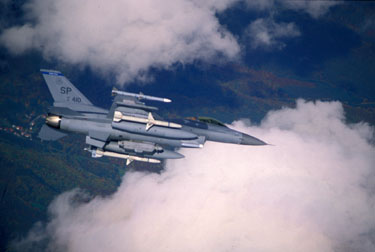 |
| An F-16CJ from the 23rd
Fighter Squadron, Spanghdalem AB, Germany, is
outfitted to hunt surface-to-air missile sites. |
Twenty-five years ago, the first production F-16s began
rolling into the Air Force inventory. Since then, the
lightweight, multirole fighter has more than lived up to
the prediction of its designers that it would prove to be
a revolutionary weapons system.
Over the years, the F-16 has shown that cutting-edge
technology does not always have to bring with it
exorbitant cost, that bigger is not always better, and
that a good basic design, with proper upgrades, can serve
many roles. It has pioneered high G cockpits, fly-by-wire
controls, “relaxed stability” aerodynamics, and other
features now common in newer aircraft models.
The F-16 has an official name—Fighting Falcon—that
nobody uses. To those who fly, arm, or maintain it, it is
“the Viper.” It has been the most popular fighter of its
time, with some 4,100 F-16s delivered to more than 20
countries. It has flown more than 200,000 combat sorties.
Its air combat record: 71-to-zero.
“We consider the F-16 to be the most versatile fighter
in the world,” said John L. Bean, Lockheed Martin vice
president in charge of F-16 operations.
For all that, the F-16’s original proponents were
something of an underground cell. Their association dated
from an evening in the mid-1960s when a General Dynamics
engineer named Harry Hillaker was sitting in the Officers’
Club at Eglin AFB, Fla., having an after-dinner drink.
Hillaker’s host introduced him to a tall, blustery pilot
named John R. Boyd, who immediately launched a frontal
attack on GD’s F-111 fighter. Hillaker was annoyed but
bantered back.
A few days later, he received a call—Boyd had been
impressed by Hillaker’s grasp of aircraft conceptual
design and wanted to know if Hillaker was interested in
more-organized meetings.
Thus was born a group that others in the Air Force
later dubbed the “fighter mafia.” Their basic belief was
that fighters did not need to overwhelm opponents with
speed and size. Experience in Vietnam against nimble
Soviet-built MiGs had convinced them that technology had
not yet completely turned air-to-air combat into a
long-range shoot-out.
As a tactics instructor at Nellis AFB, Nev., Boyd had
devoted much time to analyzing the relative positions and
speed of aircraft in dogfights. He developed what he
called a theory of energy maneuverability, which held that
a pilot lost advantage in combat when he allowed his
aircraft’s potential energy to decay to less than that of
his opponent.
“Winning required the proper management of energy
available at the conditions existing at any point during a
combat engagement,” wrote Hillaker in 1997.
The fighter mafia’s premise was that an aircraft that
was superior in acceleration and turning radius would also
prove superior in combat. The theory was not popular with
the rest of the Air Force. Other fighter theorists
emphasized top speed and weapons capability. Many were
also put off by Boyd’s personality, which was blunt to the
point of brutal.
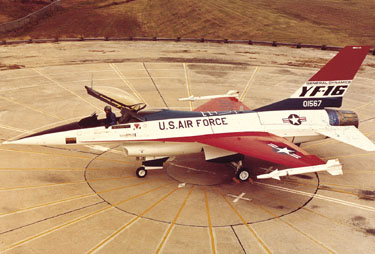 |
| The “fighter mafia” pushed
for consideration of a small, lightweight fighter. A
competition pitted the General Dynamics YF-16
prototype against Northrop’s YF-17. USAF selected the
GD entry. |
The Air Force had gone for decades without a new
fighter, and top officials were solid in their support of
development and production of the dual-engine F-15. Some
perceived the underground push for a lightweight
dogfighter to be a threat, according to Hillaker, who was
later honored as the father of the F-16.
Critics viewed the notion of a lightweight fighter in
the context of the Air Force’s experience with the F-104,
a hot airplane that was popular with pilots but had little
range and little capability. It was not bought in large
quantities by the US Air Force.
The fighter mafia felt just as strongly that there were
quantifiable advantages to their approach. A small
aircraft would enjoy a high thrust-to-weight ratio. Small
aircraft have less drag—the original F-16 design had about
one-third the drag of an F-4 in level flight and
one-fifteenth the drag of an F-4 at a high angle of
attack.
Small aircraft might also be the way to break the
ever-rising unit cost of fighters, thought Hillaker, Boyd,
and a few others. They plotted flyaway costs of successive
aircraft, beginning with the P-51, and discovered that
cost-per-pound increased at the same rate as the overall
cost. (This ended up being true for the F-16 as well—its
cost-per-pound was significantly higher than previous
models, but, since it was much smaller, overall cost was
kept down.)
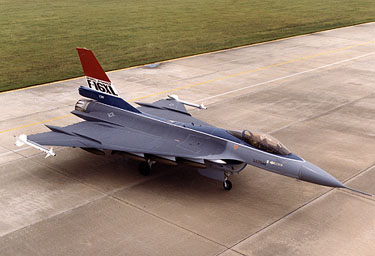 |
| Among the many
F-16 variants was the delta-wing F-16XL. Compared to
the standard F-16, it could carry more fuel and
ordnance, but USAF went with the F-15E Strike Eagle
for the deep interdiction role. |
Eventually, the Air Force gave General Dynamics and
Northrop small contracts to study the trade-offs inherent
in maneuverable aircraft. GD’s conclusion: It was possible
to produce a fighter that was twice as maneuverable as an
F-4D and had twice its mission radius, yet weighed 17,000
pounds instead of the 29,000 pounds of the F-4D.
This caught the attention of Deputy Secretary of
Defense David A. Packard, among others. Put off by the
results of the procurement of the F-111, Packard wanted to
experiment with a return to prototyping. A lightweight
fighter technology program, he felt, might be a good way
to start.
“The rest is history,” said Hillaker.
The new lightweight fighter technology effort was
formally launched in January 1972. Five firms responded
with proposals. In April, the military chose two to
proceed: the General Dynamics YF-16 and Northrop’s YF-17.
First rollout of the YF-16 came just 20 months later,
on Dec. 13, 1973.
First flight took place at Edwards AFB, Calif., on Jan.
20, 1974—inadvertently. During high-speed taxi tests the
aircraft became unstable—so much that its wingtips were
hitting off the runway and throwing off sparks. General
Dynamics test pilot Phil Oestricher decided that the
safest thing to do was take to the air. He did one circuit
and then landed.
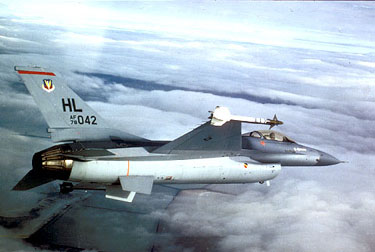 |
| In January
1979, an F-16 of the 388th Fighter Wing, Hill AFB,
Utah (at top) became the first operational F-16. |
The problem turned out to be the aircraft’s electronic
fly-by-wire control system, which was too sensitive to the
pilot’s touch. After re-tuning, the prototype made a
straightforward formal first flight on Feb. 2.
In April 1974, the stakes of the competition were
raised when Secretary of Defense James R. Schlesinger
announced that the winner would go into full-scale
development and production. This new “Air Combat Fighter”
program was supposed to produce a no-frills daylight and
good weather aircraft that could be purchased in large
quantities to supplement smaller buys of the more
expensive F-15.
Throughout 1974, the YF-16 and YF-17 went through
batteries of tests and air combat trials against
everything from F-106 Delta Darts and F-4 Phantoms to
clandestinely obtained Soviet MiGs. In close air combat,
the YF-16 appeared clearly superior. At one point, a YF-16
prototype took three straight engagements against an F-4,
which then had to land to refuel. Still airborne, the
YF-16 then bested a second Phantom sent up to resume the
fight.
The YF-16 also had an advantage over the YF-17 in that
the GD aircraft was powered by a single F100 engine—the
main power plant for the F-15. USAF officials knew that,
with two aircraft using the same type engine, unit costs
might go down and logistics would be simplified.
The Winner
In January 1975, Air Force Secretary John L. McLucas
formally declared the General Dynamics YF-16 the winner of
the competition.
Initial plans called for a buy of 650 aircraft at a
cost of $4.35 billion. The fighter might well prove
popular on the foreign market, Lucas suggested at the
time. He predicted that it might eventually sell as many
as 3,000 units.
GD delivered the first production F-16 to the Air Force
on Aug. 18, 1978. The 388th Tactical Fighter Wing, Hill
AFB, Utah, received the first operational F-16 on Jan. 6,
1979, 25 years ago this month.
Foreign sales of the new fighter began at almost at the
same time, with the first going to the Belgian Air Force
and others to the Royal Netherlands Air Force not long
afterward.
The F-16’s now-familiar, shark-like visage, with stubby
cropped delta wings and large tail, is a highly integrated
aerodynamic configuration. The wings and main fuselage are
blended together in three dimensions, creating a shape
that improves lift at high angles of attack.
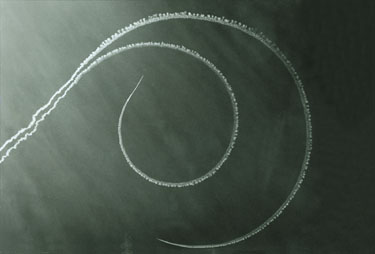 |
| An F-16
demonstrates its remarkably tight turning radius
against an F-4E. |
The airframe is conventional, composed of 80 percent
aluminum alloys, eight percent steel, and the rest
composites and exotic metals. There are so many access
panels—228 in the original design—that the aircraft looks
unfinished when a large number are opened.
Fuel capacity is surprisingly large for a small
aircraft, so much so that fuel accounts for about
one-third of the aircraft’s fully loaded weight.
With current power plants (either the Pratt and Whitney
F100 or the General Electric F110), the aircraft can reach
Mach 2 at high altitude. Its ceiling is above 50,000 feet,
and its ferry range is more than 2,000 miles.
Standard armament includes an internally mounted 20 mm
cannon with 500 rounds. Modern Block 50 versions can carry
up to 22,000 pounds of weapons, electronic
countermeasures, sensor pods, or fuel tanks on 11 external
stations.
Pilots sit up high, in a 30-degree reclining seat whose
position helps them pull up to nine Gs in a turn. The
frameless canopy provides excellent vision. Overall the
impression is almost of riding outside the aircraft,
rather than in it. It’s like being in a glass bubble with
a clear view in all directions.
A sidestick controller is mounted on the pilot’s right.
Originally the stick was simply pressure sensitive, not
moveable like a joystick, but it was later modified to
move slightly so as to improve pilot feel.
The “Electric Jet”
That the stick could be fixed was possible only because
of one of the F-16’s revolutionary advances: fly-by-wire
technology. As the first Air Force fighter to completely
replace mechanical controls with electronic ones, the
airplane was sometimes called the “Electric Jet.” That
nickname faded away as fly-by-wire controls became more
common.
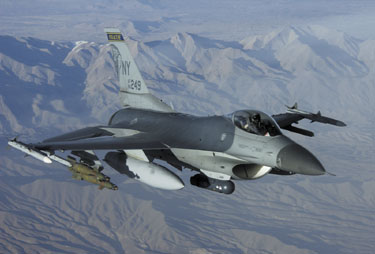 |
| Over the years,
F-16 equipment and armament have changed to keep pace
with the threat. This New York Air National Guard F-16
flying over Afghanistan has a targeting pod and
500-pound laser guided bombs. |
In turn, fly-by-wire made possible another of the
F-16’s advances: relaxed stability. With a computer
sensing directional deviations and helping control the
airplane, the F-16 can safely fly with its center of
gravity behind its center of pressure. This makes the
aircraft inherently unstable—but also highly responsive.
Over the last quarter-century, the F-16 has proved to
be a mainstay for more than just the US Air Force. It is
the most international fighter in the world, serving
currently in the air arms of some 20 countries. Four
more—the United Arab Emirates, Chile, Oman, and
Poland—will take delivery of F-16s over the next three
years, pushing total airframe production over the 4,400
mark.
Unlike many sophisticated US weapons systems, the F-16
was available for foreign military sales from the
beginning. Under an unusual agreement for the time, a
consortium of four NATO nations—Belgium, Denmark, the
Netherlands, and Norway—jointly produced F-16s with the US
starting in 1979. The aircraft used components made in all
five countries, with final assembly lines in Belgium and
the Netherlands.
The benefits of this arrangement were mutual: The
Europeans supported employment at home and got a
relatively inexpensive upgrade in military capability; the
US Air Force saved money via lower unit costs, while
supporting allied interoperability.
The F-16 is also the primary strike aircraft of the
Israeli Defense Force. Deliveries to Israel began in July
1980. The first 75 Israeli F-16s were Block 10/15 models
originally ordered by the Shah of Iran. His overthrow put
the airplanes back on the market.
Into Combat
The combat debut of the F-16 occurred on April 28,
1981, when Israeli Defense Force F-16s shot down two
Syrian Mi-8 helicopters over Lebanon. Less than two weeks
later, eight IDF F-16s destroyed Iraq’s Osirak nuclear
reactor during a famous and daring raid. Because of the
high accuracy of the F-16’s bombing computer, the Israelis
were able to strike Osirak with conventional dumb bombs,
instead of laser guided munitions.
Overall, the Israeli use of F-16s has been highly
successful. During Israel’s incursion into Lebanon in the
early 1980s, IDF F-16s had a record of 44-to-zero in air
battles with Syrian MiGs.
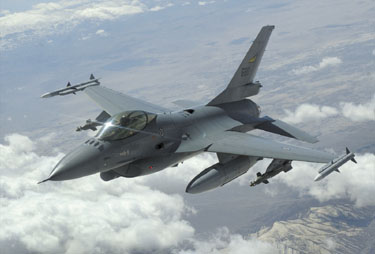 |
| Norway is one
of more than 20 countries that fly the F-16. This
Norwegian Viper is escorting US C-130s operating in
Southwest Asia. The F-16 has amassed some 200,000
combat flying hours. |
The second nation to use the F-16 in combat was
Pakistan, which began taking delivery of A/B models in
October 1982. During the chaos of the Soviet experience in
neighboring Afghanistan, Pakistani F-16s tangled with
Afghan Air Force intruders on a number of occasions. At
least eight Afghan airplanes were shot down. During an
encounter on April 29, 1987, a Pakistani F-16 was also
shot down. Subsequent investigation revealed that that the
airplane probably was a casualty of friendly fire from
another F-16.
Other nations that have bought F-16s in quantity are
Egypt, Turkey (which built its own final assembly line),
Greece, and South Korea.
The basic F-16 airframe has been produced in a
bewildering array of models, mods, and blocks during the
last quarter-century. Lockheed Martin, which bought the
former General Dynamics assembly line in 1992, now counts
more than 110 different F-16 versions.
The exterior look of the aircraft may remain the same,
but the interior has changed dramatically. There have been
six major block changes, four generations of core
avionics, five engine versions, five radar versions, five
electronic warfare suites, and at least two versions of
most other subsystems. The main F-16 computer of today has
2,000 times the memory of that in the 1978 F-16.
Though conceived as a simple dayfighter, the F-16
quickly became something more. Since November 1981, all
delivered aircraft have had built-in wiring and structural
provisions for precision strike, night attack, and
beyond-visual-range interception missions.
And the dogfighting role envisioned by the fighter
mafia 25 years ago did not play out in the combat debut of
USAF’s F-16. Instead, on Dec. 27, 1992, an F-16D faced
down an Iraqi MiG-25 with a single AIM-120A Advanced
Medium-Range Air-to-Air Missile fired at a range of about
three miles. Two USAF F-16s were patrolling the no-fly
zone over southern Iraq when they spotted the MiGs
repeatedly breaching the zone. After ignoring warnings,
one was shot down by the AMRAAM in the first USAF
air-to-air kill credited to the F-16.
The F-16 constitutes more than 50 percent of USAF
fighter strength through at least 2010, when its
replacement, the F-35 Joint Strike Fighter, begins to
enter the inventory. Current projections call for F-16s to
remain in the US inventory for at least a decade after
that and until at least 2030 for other nations.
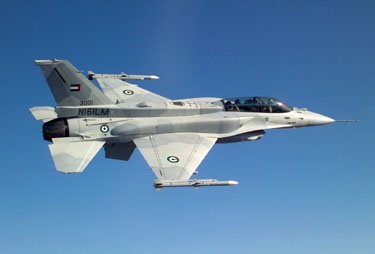 |
| This is the
newest Viper—the Block 60 version. It was designated
F-16E/F and was destined for the United Arab Emirates
this year. The first combat use of an F-16 came in
1981 by a foreign air force, the Israeli Defense
Force. |
“We expect the F-16 to remain a significant portion of
our business for many years,” said Dain M. Hancock,
president of Lockheed Martin Aeronautics, in a statement
issued to commemorate the 25th anniversary of global
production.